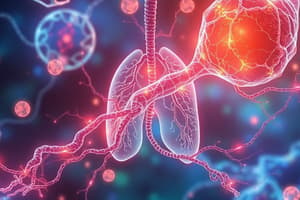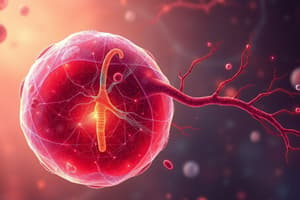Podcast
Questions and Answers
What is the primary purpose of respiration in living organisms?
What is the primary purpose of respiration in living organisms?
- To remove oxygen from the body
- To synthesize proteins
- To produce glucose
- To exchange gases with the surroundings (correct)
Which molecule is released as a form of energy during cellular respiration?
Which molecule is released as a form of energy during cellular respiration?
- ATP (correct)
- Insulin
- RNA
- Glycogen
Where does glycolysis occur in a cell?
Where does glycolysis occur in a cell?
- Cytoplasm (correct)
- Nucleus
- Endoplasmic reticulum
- Mitochondrial matrix
Which of the following is a byproduct of aerobic respiration?
Which of the following is a byproduct of aerobic respiration?
In which organelle does the citric acid cycle (Krebs cycle) occur?
In which organelle does the citric acid cycle (Krebs cycle) occur?
What is the final stage of aerobic respiration that involves the use of oxygen?
What is the final stage of aerobic respiration that involves the use of oxygen?
Where does photosynthesis take place in plants?
Where does photosynthesis take place in plants?
What is the main end product of anaerobic respiration?
What is the main end product of anaerobic respiration?
How do animals acquire oxygen for cellular respiration?
How do animals acquire oxygen for cellular respiration?
What is the function of hemoglobin in red blood cells during respiration?
What is the function of hemoglobin in red blood cells during respiration?
In which organisms can you find specialized respiratory adaptations for high-pressure environments?
In which organisms can you find specialized respiratory adaptations for high-pressure environments?
How does anaerobic respiration differ from aerobic respiration in terms of glucose oxidation?
How does anaerobic respiration differ from aerobic respiration in terms of glucose oxidation?
Flashcards are hidden until you start studying
Study Notes
Life Processes: Exploring Respiration
Life is a dynamic dance between growth, reproduction, and maintaining a steady internal environment. As a vital life process, respiration is the exchange of gases between an organism and its surroundings, ensuring the continuous supply of oxygen and the removal of carbon dioxide. While it may seem like a simple process, respiration is essential to sustain the delicate balance of life within every living being on Earth.
Cellular Respiration
Respiration occurs at the cellular level, primarily through three pathways: glycolysis, the citric acid cycle (also known as the Krebs cycle or TCA cycle), and oxidative phosphorylation (or electron transport chain). During these processes, glucose is broken down into carbon dioxide and water, with energy released in the form of ATP (adenosine triphosphate) molecules. The overall reaction is:
[ C_6H_{12}O_6 + 6O_2 \rightarrow 6CO_2 + 6H_2O + ATP ]
Aerobic Respiration
This form of respiration requires oxygen to take place and is the most efficient method for generating ATP. The majority of cellular respiration occurs through aerobic respiration in eukaryotic organisms. The process begins with glycolysis, which occurs in the cytoplasm, and continues with the citric acid cycle within the mitochondria's inner membrane. Oxygen is then utilized during oxidative phosphorylation, which takes place in the mitochondrial matrix.
Anaerobic Respiration
When oxygen is not available, organisms rely on anaerobic respiration. This alternative method yields less ATP compared to aerobic respiration. In aerobic respiration, glucose is fully oxidized to carbon dioxide, while in anaerobic respiration, incomplete oxidation occurs, resulting in the production of organic acids, alcohols, or gases like carbon dioxide and methane.
Plant Respiration
Plants, like animals, must take in oxygen and give off carbon dioxide through photosynthesis and cellular respiration. However, the processes occur in separate structures: photosynthesis takes place in chloroplasts, while cellular respiration occurs in mitochondria. During the day, plants produce more oxygen than they consume, and at night, they consume more oxygen than they produce.
Animal Respiration
Animals acquire oxygen through their respiratory systems, including lungs in terrestrial organisms and gills for aquatic animals. Gases are exchanged through the diffusion of oxygen and carbon dioxide across the moist inner surfaces of the respiratory organs. Oxygen diffuses into the bloodstream, where it is carried to cells by hemoglobin in red blood cells. Carbon dioxide is produced by cells and transported by the blood to the lungs, where it diffuses out of the blood and into the atmosphere.
Respiratory Adaptations
Different organisms have evolved unique respiratory structures and processes to suit their specific environments. For example, some deep-sea animals have specialized hemoglobin to capture oxygen at high pressures, while some insects can use alternative respiratory structures when their primary ones are compromised, such as diving beetles that can breathe through their wings.
In conclusion, respiration is a fundamental life process, serving as the interface between an organism and its environment. It is essential for the continuous supply of oxygen and removal of carbon dioxide, ensuring that living organisms can sustain the growth, reproduction, and maintenance of life. Through the process of cellular respiration, organisms produce energy in the form of ATP, which fuels life's many essential processes.
Studying That Suits You
Use AI to generate personalized quizzes and flashcards to suit your learning preferences.




